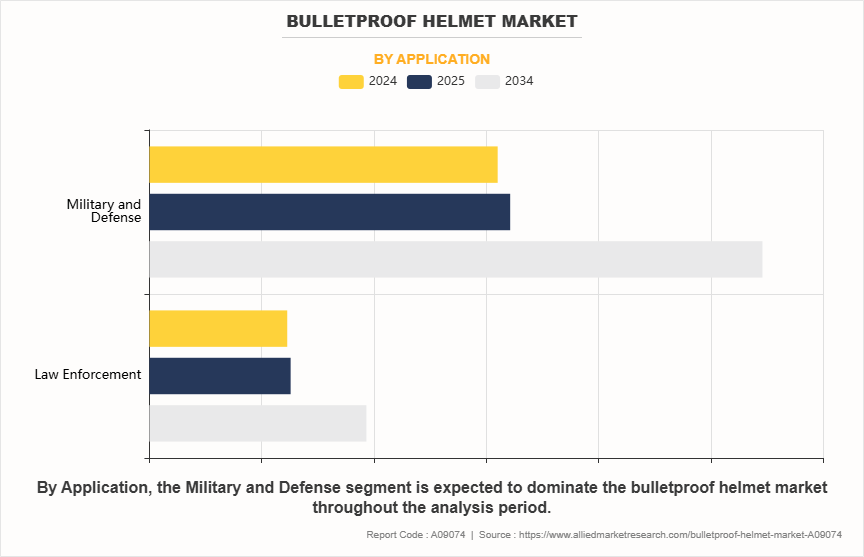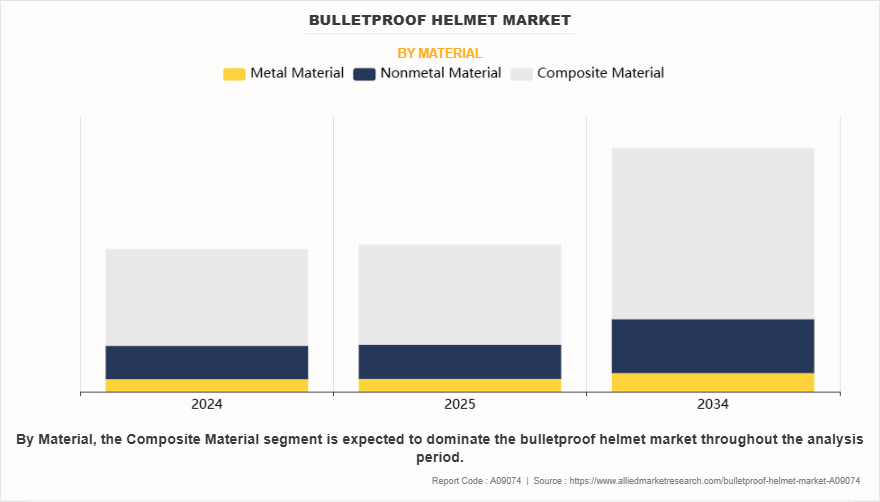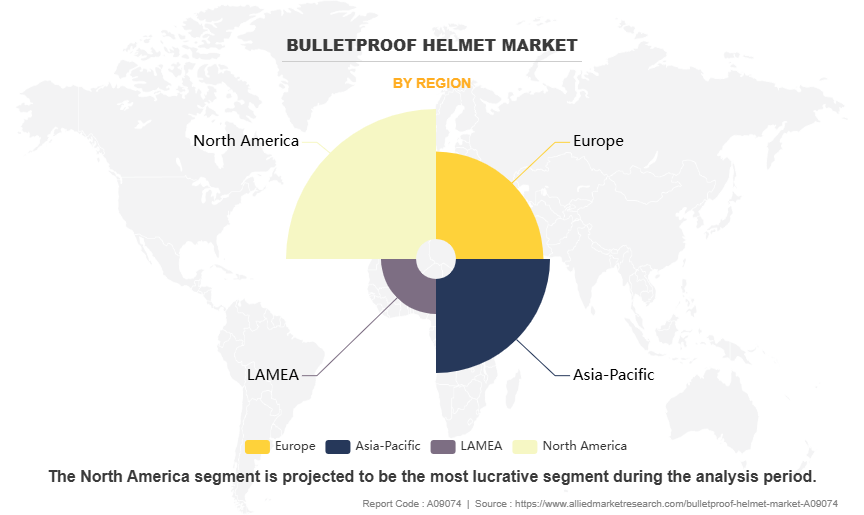Bulletproof Helmet Market Research, 2034
The global bulletproof helmet market size was valued at $1.3 billion in 2024, and is projected to reach $2.2 billion by 2034, growing at a CAGR of 5.7% from 2025 to 2034.

A bulletproof helmet is a type of personal protective equipment designed to protect the head from ballistic threats such as bullets, shrapnel, and other projectiles. It is commonly used by military personnel, law enforcement officers, and security forces during combat operations, tactical missions, or riot control. These helmets are made from strong materials such as Kevlar, aramid fibers, or composite materials that are lightweight yet capable of absorbing and deflecting energy from high-speed impacts.
Modern bulletproof helmets have evolved beyond basic protection, now incorporating advanced features such as mounts for night vision devices, integrated communication systems, and modular face shields. These enhancements make them versatile for various operational scenarios, from urban counter-terrorism to battlefield engagements. Furthermore, rigorous testing against international ballistic standards ensures reliable performance against specified threat levels.
Moreover, with a growing emphasis on technologically advanced and high-performance protective gear, Indian defense manufacturer MKU Limited has supplied its advanced helmets to enhance soldier safety and operational effectiveness. For instance, in February 2025, Indian defense manufacturer MKU Limited supplied its Kavro Doma 360 ballistic helmet to the Indian Army, as confirmed by company representatives during Aero India 2025. While officials disclosed that the helmet has entered service and is undergoing foreign trials, specific details about these evaluations remain undisclosed.
The Kavro Doma 360 is engineered to stop multiple high-velocity rounds, including 7.62×39 mm MSC bullets from AK-47 rifles, along with standard NATO ammunition (7.62×51 mm and 5.56×45 mm). MKU emphasizes its lightweight design (under 1.2 kg), along with features like anti-allergic padding, all-weather durability, chemical resistance, and optimized shock absorption. Notably, it maintains a backface deformation (BFS) below 20 mm upon impact, exceeding typical safety thresholds.
Moreover, as policing strategies shift toward community-based models and less-lethal engagements, there is an increased need for protective gear that balances safety with mobility. In addition, the lower manufacturing cost of nonmetal helmets makes them suitable for bulk procurement in regions with limited defense resources. However, their ballistic protection level is generally lower than metal or composite options, which limits their usage in high-intensity combat scenarios. Thus, this segment is mostly driven by affordability, operational comfort, and suitability for low-risk environments.
Increase in global defense expenditure, rise in demand for personal protective equipment (PPE) among military and law enforcement, and growth in threat of asymmetric warfare and terrorism are expected to drive the of the global bulletproof helmet market growth during the forecast period. However, the high cost of advanced helmets and limited demand from non-military segments are anticipated to hamper market growth during the same period.
Moreover, rising demand from emerging economies for modernizing defense forces and the integration of smart technologies in helmets are expected to offer lucrative opportunities for the market in the future. Moreover, as policing strategies shift toward community-based models and less-lethal engagements, there is an increased need for protective gear that balances safety with mobility. In addition, the lower manufacturing cost of nonmetal helmets makes them suitable for bulk procurement in regions with limited defense resources.
The bulletproof helmet industry is segmented into material, application, and region. On the basis of material, the market is divided into metal material, nonmetal material, and composite material. As per application, the market is segregated into law enforcement and military and defense. Region wise, the market is analyzed across North America, Europe, Asia-Pacific, and LAMEA.
Leading players and their key business strategies have been analyzed in the report to gain a competitive insight into the market. Key players covered in the report include Marom Dolphin, Schuberth, Team Wendy, EnGarde Body Armor, Legacy Safety and Security, MARS Armor, Protection Group Danmark Wholesale Aps, VestGuard UK Ltd., Sarkar Tactical, and Compass Armor Gear.
Key Developments
The leading companies have adopted strategies such as acquisition, agreement, expansion, partnership, contracts, and product launches to strengthen their market position.
- In April 2024, TEAM WENDY & its parent company Avon Protection plc Group planned to expand in Clair Avenue in Cleveland, U.S. Thisstrategy added 200 new jobsto its currentstaff that are located at 17000 St. in Cleveland.
- In January 2024, TEAM WENDY launched a prototype of rifle rated helmet, a non-ballistic nape guard and various new face shieldsin SHOT Show being held in Las Vegas, U.S. The helmet meetsthe NIJ IIIA standard for ballistic performance, with the added ability ofstopping higher velocity threats.
- In November 2023, SCHUBERTH received a contract from the Romanian Ministry of Defense and a Swissspecial forces unit to supply M100 ballistic protective helmets. This contact was delivered via sales partner Alpine Fox in Switzerland and Rotman Industries SRL in Romania before the end of 2023. The M100 is a modern combat helmet with superior wearing comfort and a high level of ballistic protection.
Segmental Analysis
The bulletproof helmet market is segmented into material, application, and region. On the basis of material, the market is divided into metal material, nonmetal material, and composite material. As per application, the market is segregated into law enforcement and military and defense. Region wise, the market is analyzed across North America, Europe, Asia-Pacific, and LAMEA.
By Application
By application, the global bulletproof helmet market is categorized into law enforcement and military and defense. The military and defense segment accounted for the largest market share in 2024. This growth is driven by ongoing military modernization efforts, increasing global defense budgets, and the rising frequency of asymmetric warfare and border conflicts.

By Material
By material, the global bulletproof helmet market is divided into metal material, nonmetal material, and composite material. The composite material segment accounted for the largest market share in 2024, driven by ongoing military modernization efforts, increasing global defense budgets, and the rising frequency of asymmetric warfare and border conflicts. Helmets used in this segment are designed for high performance combat scenarios and are often made from advanced composite materials to offer maximum protection with minimal weight.

By Region
Region wise, North America held the largest bulletproof helmet market share in 2024. due to high defense spending, strong military capabilities, and advanced law enforcement systems. The U.S. is the biggest contributor to this region’s market due to its continuous investment in military modernization and homeland security. Moreover, the U.S. Department of Defense regularly updates its equipment to include the latest ballistic technologies, which boosts bulletproof helmet market demand with smart features and lightweight material.

Increasing Global Defense Expenditure
The rise in global defense expenditure is a major driver of the bulletproof helmet market. Many countries are continuously increasing their military budgets to strengthen national security and modernize their armed forces. This rise in spending creates a strong demand for advanced protective equipment, including bulletproof helmets. Governments are allocating more funds towards purchasing high-quality gear that can protect soldiers in high-risk environments.
Moreover, defense modernization programs in countries such as the U.S., China, India, and Russia have led to largescale procurement of personal protective equipment. These countries aim to equip their armed forces with the latest technology and improve the overall combat readiness of their troops. Bulletproof helmets are considered essential for this modernization effort, as they offer protection against ballistic threats and head injuries. In addition, international tensions and regional conflicts have further encouraged nations to invest in defense. As a result, military organizations are focusing more on improving the safety and survivability of their personnel during operations. The growing defense budgets not only support the development of new helmet technologies but also ensure regular upgrades and replacement of existing protective gear.
Furthermore, peacekeeping missions and international military cooperation have led to joint investments in safety equipment. Bulletproof helmets are often part of the standard gear for such missions, contributing to the increased global demand. Overall, as countries continue to prioritize defense spending, the bulletproof helmet market is expected to experience steady growth.
Rise in demand for personal protective equipment (PPE) among military and law enforcement
One significant driver for the bulletproof helmet market is the rise in demand for personal protective equipment (PPE) among military and law enforcement agencies. This demand is being driven by the increasing number of conflict zones, counter-terrorism operations, and internal security threats faced by many countries around the world. As soldiers and law enforcement officers are often the first line of defense in such situations, governments are placing a stronger focus on equipping them with advanced protective gear to ensure their safety during high-risk operations.
Moreover, modern warfare and policing have evolved to include urban and close-quarter combat, which exposes personnel to a higher risk of head injuries from bullets, shrapnel, and blunt force trauma. In such conditions, bulletproof helmets have become essential for survival and effectiveness. In addition, the rise in organized crime, armed insurgencies, and cross-border tensions have compelled nations to strengthen their internal security apparatus. This includes investing in high-quality PPE such as helmets, body armor, and ballistic shields.
Furthermore, the growing awareness among military forces and police departments about the long-term health consequences of head injuries has also contributed to this trend. Bulletproof helmets not only offer ballistic protection but also often include compatibility with communication systems and night-vision devices, making them even more valuable in modern missions. As a result, the need for better protection, combined with advancements in helmet technology, is expected to continue driving the market forward.
High cost of advanced helmets
One key restraint for the bulletproof helmet market is the high cost of advanced helmets. These helmets are typically made using cutting-edge materials such as aramid fibers, ultra-high-molecular-weight polyethylene (UHMWPE), and advanced composites. While these materials offer excellent protection against ballistic threats, they also significantly increase the overall cost of production. Moreover, the integration of modern features such as night vision compatibility, communication systems, and impact sensors further raises the price of each unit. In addition, many countries, especially those with smaller defense budgets, find it difficult to afford large-scale procurement of such expensive equipment. This limits the adoption of the most advanced helmets to only a few elite units or special forces, leaving the rest of the military with older or less protective models. Furthermore, for countries facing economic challenges or other pressing priorities, investing in high-end protective gear may not be a top priority, which can slow down market growth.
Demand From Emerging Economies for Modernizing Defense Forces
One promising opportunity for the bulletproof helmet market is the rising demand from emerging economies for modernizing their defense forces. Many developing countries are now focusing on upgrading their military capabilities due to growth in regional tensions, rise in security challenges, and the need to match global defense standards. As part of this modernization process, there is a growing emphasis on improving the personal safety of soldiers, which includes providing them with modern bulletproof helmets. For example, countries such as India, Brazil, Indonesia, and Vietnam have started investing heavily in defense modernization programs. These programs often include the procurement of advanced personal protective equipment (PPE) to ensure that troops are better protected during combat and peacekeeping operations. Moreover, in regions where border conflicts and internal insurgencies are common, the need for updated and effective protective gear becomes even more important. In addition, international defense partnerships and technology transfers have allowed several emerging economies to access modern manufacturing techniques and materials. This has enabled them to either produce bulletproof helmets domestically or import them at more affordable rates. Furthermore, global events such as joint military exercises, United Nations peacekeeping missions, and rising terrorism threats are also encouraging these nations to equip their personnel with internationally accepted protective standards. As a result, the expanding defense budgets and modernization efforts in emerging economies present a significant growth opportunity for bulletproof helmet manufacturers. Companies that can offer cost-effective, reliable, and customizable solutions are expected to benefit the most from this rising demand.
Key Benefits For Stakeholders
- This report provides a quantitative analysis of the market segments, current trends, estimations, and dynamics of the bulletproof helmet market analysis from 2024 to 2034 to identify the prevailing bulletproof helmet market opportunities.
- The market research is offered along with information related to key drivers, restraints, and opportunities.
- Porter's five forces analysis highlights the potency of buyers and suppliers to enable stakeholders make profit-oriented business decisions and strengthen their supplier-buyer network.
- In-depth analysis of the bulletproof helmet market segmentation assists to determine the prevailing market opportunities.
- Major countries in each region are mapped according to their revenue contribution to the global market.
- Market player positioning facilitates benchmarking and provides a clear understanding of the present position of the market players.
- The report includes the analysis of the regional as well as global bulletproof helmet market trends, key players, market segments, application areas, and market growth strategies.
Bulletproof Helmet Market Report Highlights
| Aspects | Details |
| Market Size By 2034 | USD 2.2 billion |
| Growth Rate | CAGR of 5.7% |
| Forecast period | 2024 - 2034 |
| Report Pages | 340 |
| By Application |
|
| By Material |
|
| By Region |
|
| Key Market Players | Legacy Safety and Security, Team Wendy, Compass Armor Gear, VestGuard UK Ltd., SCHUBERTH, MARS Armor, Sarkar Tactical, PROTECTION GROUP DANMARK WHOLESALE APS, MAROM DOLPHIN, EnGarde Body Armor |
The leading application of Bulletproof Helmet Market is military and defense
The upcoming trends of Bulletproof Helmet Market in the globe are rising demand from emerging economies for modernizing defense forces and the integration of smart technologies in helmets.
The largest regional market for Bulletproof Helmet is North America
The global bulletproof helmet market was valued at $1,298.3 million in 2024, and is projected to reach $2,216.9 million by 2034, growing at a CAGR of 5.7% from 2025 to 2034.
The key players in the bulletproof helmet market are Marom Dolphin, Schuberth, Team Wendy, EnGarde Body Armor, Legacy Safety and Security, MARS Armor, Protection Group Danmark Wholesale Aps, VestGuard UK Ltd., Sarkar Tactical, and Compass Armor Gear.
Loading Table Of Content...
Loading Research Methodology...



